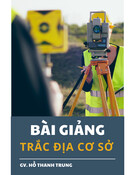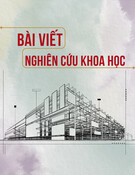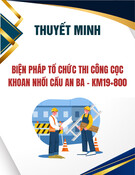
H. Nhat Duc, T. Van Duc,... / Tạp chí Khoa học và Công nghệ Đại học Duy Tân 04(65) (2024) 80-89
80
Classification of asphalt pavement crack severity using gradient
boosting machine and image processing techniques
Phân loại vết nứt mặt đường sử dụng mô hình học máy tăng cường và các kỹ thuật xử lý ảnh
Hoang Nhat Duca,c*, Tran Van Ducb,c, Nguyen Quoc Lamc, Pham Quang Nhatc
Hoàng Nhật Đứca,c*, Trần Văn Đứcb,c, Nguyễn Quốc Lâmc, Phạm Quang Nhậtc
aInstitute of Research and Development, Duy Tan University, Da Nang, 550000, Vietnam
aViện Nghiên cứu và Phát triển Công nghệ Cao, Trường Đại học Duy Tân, Đà Nẵng, Việt Nam
bInternational School, Duy Tan University, Da Nang, 550000, Vietnam
bViện Đào tạo Quốc tế, Trường Đại học Duy Tân, Đà Nẵng, Việt Nam
cFaculty of Civil Engineering, School of Engineering Technology, Duy Tan University, Da Nang, 550000, Vietnam
cKhoa Xây dựng, Trường Công nghệ, Trường Đại học Duy Tân, Đà Nẵng, Việt Nam
(Date of receiving article: 16/03/2024, date of completion of review: 03/04/2024, date of acceptance for posting:
10/04/2024)
Abstract
This study puts forward an innovative approach for not only detecting cracks but also recognizing their severity. Herein,
the severity of a crack object is characterized by its width. Light Gradient Boosting Machine (LightGBM) has been
employed to categorize pavement surface into five labels: non-crack, sealed crack, minor crack, moderate crack, and
severe crack. The model construction of the LightGBM requires a set of feature extractors, including steerable filters,
projection integrals, and image texture analyses. Experimental results show that the LightGBM-based method is capable
of achieving outstanding classification performance with CAR > 0.98 and F1 score > 0.95 for all class labels.
Keywords: asphalt pavement; crack severity; image processing; machine learning.
Tóm tắt
Nghiên cứu của chúng tôi đề xuất một phương pháp mới để phát hiện các vết nứt trên mặt đường và phân loại chúng dựa
trên mức độ nghiêm trọng. Phương pháp học máy tăng cường dựa trên độ dốc (LightGBM) được sử dụng để phân loại bề
mặt mặt đường thành năm nhóm: không nứt, nứt đã được trám, nứt nhỏ, nứt vừa, và nứt rộng. Chúng tôi sử dụng các bộ
lọc có thể điều chỉnh, tích phân chiếu, và phân tích kết cấu hình ảnh để trích xuất tính chất của mẫu ảnh. Kết quả tính toán
cho thấy phương pháp dựa trên LightGBM có khả năng phân loại tốt với độ chính xác lớn hơn 98% và chỉ số F1 lớn hơn
0.95 cho tất cả các nhóm ảnh.
Từ khóa: đường nhựa; mức độ của vết nứt; xử lý ảnh; học máy.
*Corresponding author: Hoang Nhat Duc
Email: hoangnhatduc@duytan.edu.vn
04(65) (2024) 80-89
DTU Journal of Science and Technology
D U Y T A N U N I V E R S I T Y
TẠP CHÍ KHOA HỌC VÀ CÔNG NGHÊ ĐẠI HỌC DUY TÂN








































